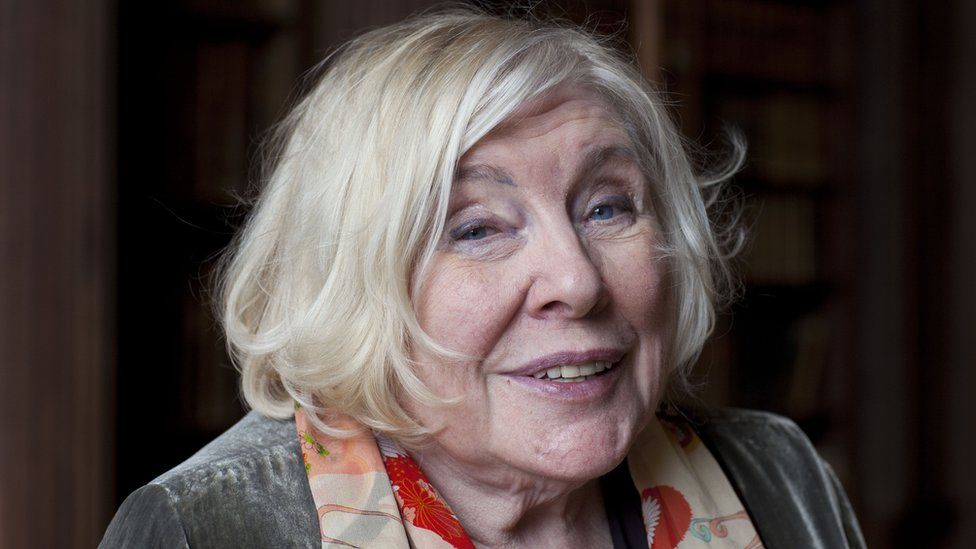ARTICLE AD BOX
 Image source, Getty Images
Image source, Getty Images
Fay Weldon was a sometimes controversial feminist, a prolific novelist, and a woman whose own life not only informed her fiction but sometimes sounded like the plot of a lurid novel.
The American writer Alison Lurie likened her to Chaucer's Wife of Bath: a storyteller who had been married several times and was practical, funny and wise.
"Many of the stories she tells have the moral of the Wife of Bath's Tale," Lurie added. "What women want is their own way. If they get it, they will make men happy; if not, not."
Fay Weldon was born in Britain but brought up in New Zealand, the daughter of a doctor, Frank Birkinshaw, and Margaret Jepson, a fledgling artist and novelist diverted by motherhood.
Art and infidelity ran in the family. Her great-grandfather was a leading violinist, who had been fired from his post at the Royal College of Music for advocating free love and had fled to America, leaving his daughter, her grandmother, behind.
Her maternal grandfather was a popular novelist, her grandmother a budding concert pianist who abandoned performing to marry young.
Image source, Museum of New Zealand
Image caption,The artist Rita Angus painted this portrait of Fay (left) and her sister, Jane, in 1938
Fay's mother, Margaret, also married young, prompted by her own father, the novelist, leaving her mother for a younger woman.
But Fay's father also turned out to be unfaithful - he and Margaret divorced when Fay was six.
"The tendency to marry faithless men comes running down the female side of the family, the tendency to faithlessness runs in the male," Fay wrote, in her memoir, Auto da Fay.
Fay and her sister Jane grew up with a single, working mother in an all-female household (her maternal grandmother eventually came to live with them) in Christchurch, New Zealand, until Margaret Birkinshaw brought her daughters back to the UK in 1946, arriving on Fay's 15th birthday.
It was a shock. London was war-ravaged, and to begin with, her mother could only find work as a live-in housekeeper. The experience proved useful in the 1970s, when Fay wrote some of the first few scripts for the TV series, Upstairs, Downstairs.
If her childhood was dysfunctional, her early adult life, as recounted in Auto da Fay, was equally rackety. At St Andrews University she had a reputation for being promiscuous but couldn't acquire a regular boyfriend. In London, she worked a succession of jobs: a hospital orderly, a waitress, a Foreign Office clerk.
She subsequently bought an old house in Saffron Walden in Essex on borrowed money and tried - with her mother, sister (pregnant) and a friend (also pregnant) - to open a tea shop. It failed.
Image source, Getty Images
Image caption,Fay Weldon worked as an advertising copywriter while living in London in the 1950s
At the time, she was pregnant herself by a penniless busker. She gave birth to a son, Nicolas - whom she raised alone. Struggling to cope financially, she was briefly married to a man more than 20 years her senior who wasn't interested in sex with her - instead he encouraged her to become a nightclub hostess and sleep with other men.
'Go to Work on an Egg'
Professionally, she found success in advertising, working as a copywriter for Ogilvy & Mather. Her team produced such well-known slogans as "Go to Work on an Egg" and "Unzip a Banana". Another, "Vodka gets you drunker quicker", never took off.
At the age of 29, she met and married a failed painter-turned-antiques dealer, Ron Weldon and settled in Somerset.
Fay Weldon was a popular voice on panel shows like Radio 4's Start the Week
More than 30 years later, she divorced him when he left her for his astrological therapist. In a dark twist worthy of a Fay Weldon novel, he dropped dead hours before the divorce became final.
Along the way they had three sons. Weldon began writing while pregnant with their eldest, Dan, in 1963.
Her early life, financially and emotionally precarious, proved excellent training for the unpredictable life of a writer.
She wrote her first television play, A Catching Complaint, in 1966. A second, called The Fat Woman's Tale, became a novel - The Fat Woman's Joke - published in 1967. Another 30 further novels followed, along with screenplays, adaptations, stage plays, radio plays, short stories and non-fiction.
Furious
Her early books were explicitly feminist, her later work more varied - perhaps reflecting changes in women's experience. "What drove me to feminism 50 years ago was the myth that men were the breadwinners, and women kept house and looked pretty," she once wrote. "That myth finally exploded, and I helped to explode it."
Her books often used elements from genre fiction - including crime thrillers, science fiction and ghost stories. What linked them was her fascination with the lives of women and their often difficult relationships with the men who exploited them, or tried to.
Image source, Getty Images
Image caption,Weldon wrote about the changing fortunes of women in the modern world.
In an early novel, Down Among the Women (1971), the unmarried and pregnant Scarlet tries to find a middle way to steer through life: neither the furious independence of her mother, a fierce 1930s radical, nor the clinging submissiveness of her father's new wife, Susan.
As Weldon wrote: "Women were betrayed by their bodies, swelling, bursting and bleeding; sex was an intermittent animal spasm; men seduced, made pregnant, betrayed, deserted."
In Praxis (1978), a woman tries on many roles during her life - from suburban housewife to harlot - and tries to balance the demands of career, children and husbands; at one point she spends two years in jail for infanticide.
The New York Times wrote: "As a narrative it is perhaps too ambitious, but as a collection of vignettes, polemics, epigrams, it is often dazzling, pointing up the mad underside of our sexual politics with a venomous accuracy for which wit is far too mild a word.
"The male, fatuous with power; the female, toadying in the hope that some of it will rub off on her: it would be hard to say which disgusts Miss Weldon more."
In arguably her most famous work, 1984's The Life and Loves of a She-Devil - which went on to become a TV series and a film - the heroine takes elaborate and merciless revenge on her adulterous husband. Along the way she undergoes cosmetic surgery to turn herself into a simulacrum of her husband's lover.
The BBC's adaptation of The Life and Loves of a She-Devil starred Patricia Hodge and Dennis Waterman
In later life, however, she didn't always endear herself to feminists, and some saw her as a traitor to the cause. Weldon went as far as to suggest that an employed mother puts a more productive teenager out of work, and that alienated children don't make good citizens.
She urged women to pick up their husbands' socks and to avoid exhausting themselves fighting for justice in the home. It worried her when fans wrote to say Weldon had given them the confidence to leave their husbands.
Weldon married for a third time in 1994, to the poet Nick Fox.
Her later books included a trilogy set in among Edwardian aristocrats, and a pithy self-help book for aspiring novelists, Why Will No-One Publish My Novel? (2018), which offered emotional support to the rejected writer, but brutally warned against having "nothing to say".
In person, Fay Weldon was cheerful, strong-willed, shrewd, mischievous and outspoken. On paper, she expressed herself in short, punchy sentences.
It was a prose style many critics sneered at. But she wittily captured the changing fortunes of women in the modern world.
"I've judged enough prizes in my time to know the most boring book wins. And that's not the book you want to write." she said.
Related Internet Links
The BBC is not responsible for the content of external sites.

 1 year ago
40
1 year ago
40








 English (US)
English (US)